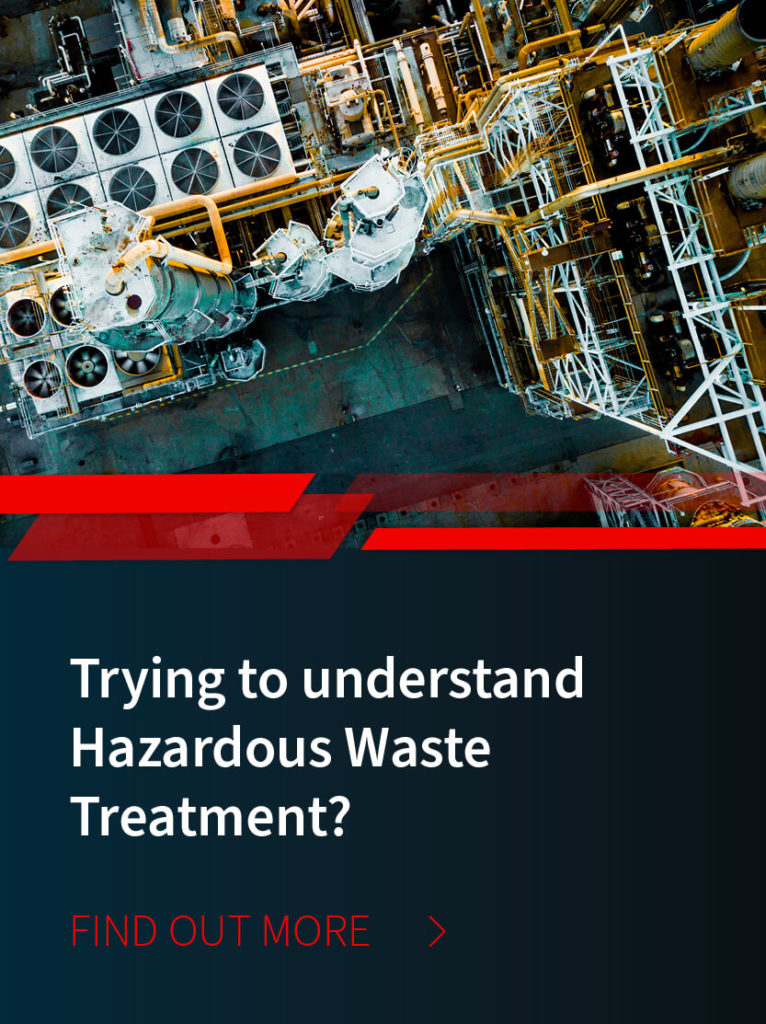
/ IN THIS BLOG
Following proper ways to collect and transport industrial waste is vital, especially with increasingly specific laws focused on protecting the environment. Any generator of industrial waste must manage and dispose of it properly and in compliance with federal and state and local laws.
01 / Know the Law
When managing industrial waste, organizations must take extra care to follow all mandatory procedures from the moment waste is generated to collection and transportation for processing and disposal. Before this can be successfully achieved, understand what industrial waste is. Generally, such waste is defined as any waste that is produced by a manufacturing or industrial process, but like other waste streams, some of that waste is non-hazardous and some of it is hazardous. Know the difference.
Turn to resources such as the Environmental Protection Agency (EPA) and their publications and regulations regarding industrial waste. One such resource is their ‘Guide to Industrial Waste Management’, a must-read by any industrial waste generator producing non-hazardous waste. For descriptions or identification of hazardous waste characteristics, turn again to the EPA’s resource for information here.
The EPA, as well as other federal, state, and local regulatory agencies, such as the Department of Transportation (DOT), have developed rules mandating how industrial waste should be collected, stored, and transported. Failure to follow these requirements can result in civil and criminal penalties and even jail time.
02 / Industrial Waste Storage Limitations
In order to fulfill the EPA's hazardous waste disposal regulations, most industrial waste generators and transporters must first obtain an EPA identification number. The form (8700-12) can be downloaded from the EPA website or obtained through most state’s Departments of Natural Resources or Environmental Protection departments.
In most scenarios, hazardous waste can be stored on-site for 90 to 180 days (depending on the amount of waste generated), but in some cases, an extension of the on-site storage period can be granted if the waste must be transported more than 200 miles for treatment and disposal.
Severe penalties exist for storing waste on-site past the allowable time period, including potential fines of up to $50,000 per day per violation (see 40 CFR 260-265). Additionally, jail time can be triggered if on- site waste treatment is deemed unacceptable.
03 / Collection of Industrial Wastes
As mentioned in the Guide for Industrial Waste Management, the EPA’s definition of non-hazardous waste is defined in Subtitle D of the RCRA as well as 40 CFR Part 257, Parts A and B. Subtitle D regulations focus on non-hazardous solid waste. Be aware that many states implement their own regulations for non-hazardous waste that are more stringent than those of the federal government.
Non-hazardous waste is defined as a waste that is NOT subject to RCRA Subtitle C regulations. Subtitle C IS about hazardous waste regulations. Yes, it can get confusing, but it’s important to review and understand the differences prior to collection and transportation of industrial wastes.
Special containers, properly labeled, sealed, and maintained, must be used to store all waste on-site. Unless the hazardous waste meets the EPA's Land Disposal Restrictions (LDR) standards, it cannot be "land disposed" and must instead be treated to reduce any hazardous constituents to a level approved by the EPA.
Under Domestic Sewerage Exclusion (DSE) regulations (every state has these), hazardous waste can be recycled or disposed of on-site as long as the waste generator can "flush" the wastes by mixing it with domestic sewage and discharging the mix into publicly owned treatment works – but only if those publicly owned treatment works (POTW) can adequately treat dangerous wastes to enter the sewer systems. Every state may have slightly different guidelines. For example, Washington state[1] exclusions apply if the waste:
Does not have any hazardous waste characteristic (flammable, corrosive, toxic, or reactivity)
Does not exceed thresholds of dangerous waste concentrations if not treatable by the POTW
Must not be a dangerous or hazardous pharmaceutical
Is treatable by the POTW to a measured degree and will not simply pass through to effluent or sludge of the facility
In some cases, recycling or on-site treatment can occur without a permit as long as the organization complies with the accumulation time limits and waste collection regulations outlined in 40 CFR Parts 260 through 268. See Part 270 for hazardous waste permit programs.
04 / Transportation of Hazardous Waste
When it comes to transportation of hazardous industrial waste (or any hazardous waste stream), turn to Subtitle C of the Resource Conservation and Recovery Act (RCRA) for details regarding off-site transporters. Specific guidelines for transporters of hazardous waste are found in the Federal Code of Regulations (CFR Title 40 Part 263).
Regulations regarding specific wastes can also be found on the EPA website, as can storage limitations regarding accrual prior to off-site transportation, as well as how that waste is to be collected prior to transportation.
When treated off-site, the method of transportation of hazardous waste must also conform to a set of health and safety procedures. Because of the danger of spills or "midnight dumping" (abandoning waste at random locations), the law requires proper labeling and tracking of all hazardous materials. Tracking is done through hazardous waste manifests that electronically follows the waste from the moment it leaves the originating facility until it reaches its off-site destination, such as a hazardous treatment or disposal facility. The manifests also records details of waste pick-up and delivery, routes, and schedules.
While trains are still sometimes used to transport hazardous waste, the most common method involves moving containers in trucks over public highways. Know the federal laws as well as state laws of your Departments of Transportation. Trucks made of steel or aluminum are allowed to carry hazardous waste containers with varying capacities, most commonly in 55-gallon drums. Again, carefully review Title 40, Part 263 – Standards Applicable to Transporters of Hazardous Waste.
05 / Find the Support You Need
While industrial waste management can be complex, the federal and your state hazardous waste energy departments provide valuable resources and assistance to help you maintain compliance when it comes to proper ways to collect and transport industrial waste. In addition, partnering with a qualified, experienced waste management provider ensures safety and proper aspects of industrial waste management.
With over three decades of experience in waste management and disposal, MCF Environmental Services provides the expertise and capabilities you need to properly handle your hazardous or non-hazardous industrial waste. Contact us today to learn more about MCF's high standards for industrial waste disposal services in your state.
Robert Losurdo
President, COO








